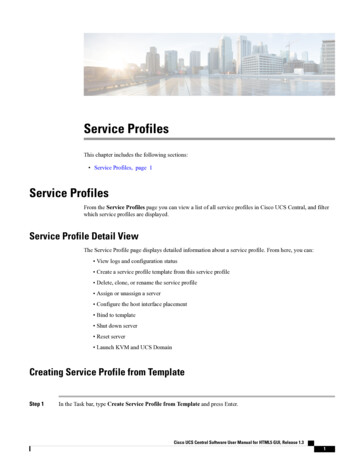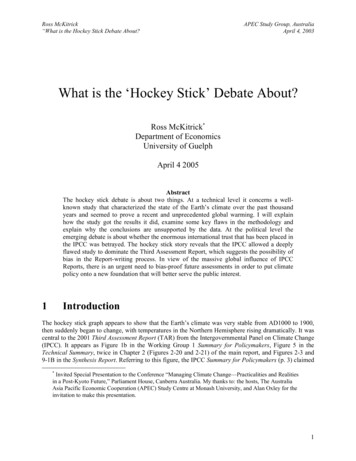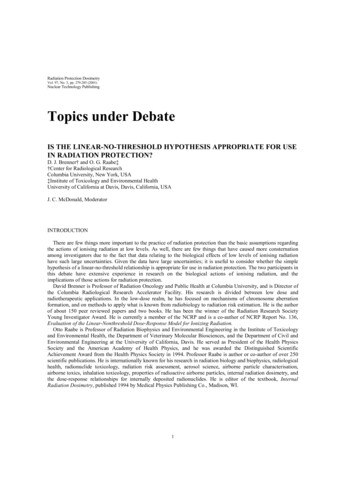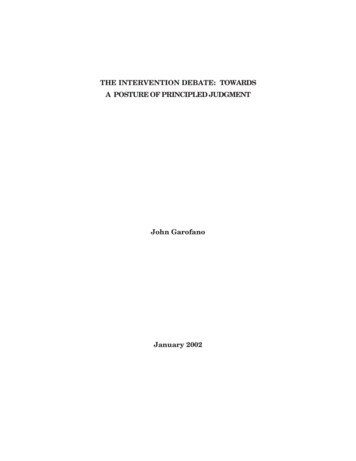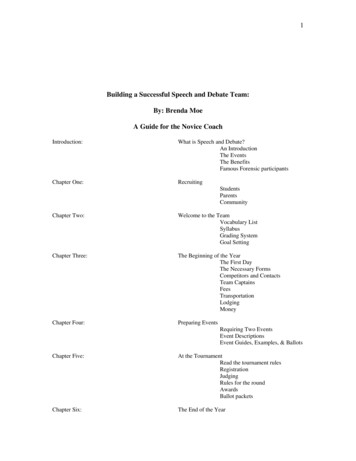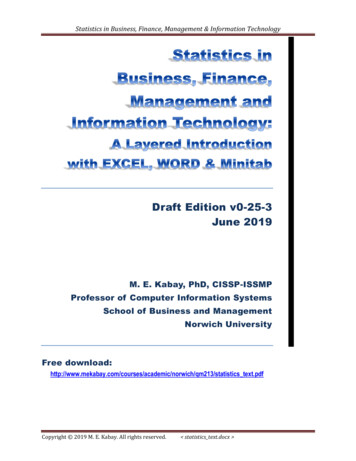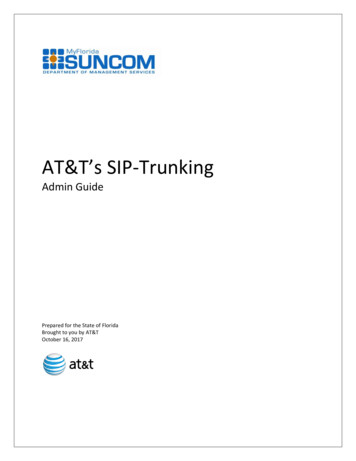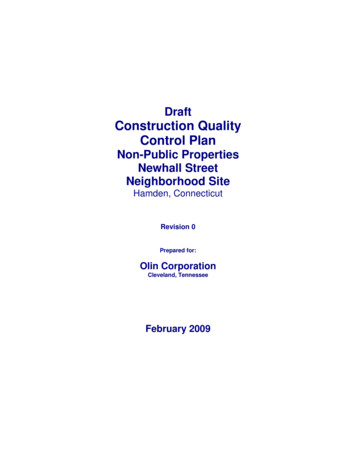
Transcription
DEBATINGSimon QuinnAvailable free at www.learndebating.com.
This book is dedicated to Andrew Denby,who repeatedly encouraged me to start writing this book.He was a good friend and a really nice guy.First published in Australia in 2005.Published electronically by the author in Brisbane, Queensland.Copyright Simon Quinn 2005All rights reserved. Apart from any fair dealing for the purposes of study, research,criticism, or review as permitted under the Copyright Act, no part of this book may bereproduced by any process without permission. Copyright owners may take legalaction against a person or organisation that infringes their copyright throughunauthorised copying. Inquiries should be directed to the author.Permission is given for this book, or any part of it, to be downloaded, printed andcopied from the website www.learndebating.com. However, without the author’sfurther express permission, you may not: provide any part of this book for download from any other website, profit in any way from the printing, distribution or promotion of any part of thisbook, modify in any way any part of this book, represent – explicitly or implicitly – that any part of this book is the work of anyother author.
First they came for the Communists, but I was not a Communist so I did not speak out.Then they came for the Socialists and the Trade Unionists, but I was neither, so I did notspeak out.Then they came for the Jews, but I was not a Jew so I did not speak out.And when they came for me, there was no one left to speak out for me.German Protestant Pastor Martin NiemoellerEvery idea is an incitement. It offers itself to belief and if believed is acted upon unlesssome other belief outweighs it or some failure of energy stifles the movement at its birth.The only difference between the expression of an opinion and an incitement in thenarrowest sense is the speaker’s enthusiasm for the result; eloquence may set fire toreason.Supreme Court Justice Oliver Wendell Holmes, dissenting inGitlow v The State of New York (1925) 268 US 652Free speech is life itself.Salman Rushdie
CONTENTSPageBEGINNERBEGINNERINTRODUCTIONDEBATING: A BASIC INTRODUCTION . .13CHAPTER ONE: PREPARATION . . . . . . . . . . . . . . . .781010101212121415171718182021 .21 .2122PREPARATION: THE BIG PICTURESTEP ONE: THE ISSUE AND DEFINITIONFINDING THE BATTLEGROUNDFINDING THE ISSUETHE DEFINITIONWHAT IS THE DEFINITION?HOW TO DEFINE A TOPICLIMITING TOPICS BY DEFINITIONTHE NEED FOR A NEUTRAL DEFINITIONTHE RIGHT OF DEFINITIONNO EXCLUSIVE RIGHTMORE REASONABLECLOSER TO THE ‘REAL’ ISSUE OF THE TOPICTHE EXCLUSIVE RIGHTTRIGGERSTRIGGERS FOR WHAT YOUR TEAM NEEDS TOPROVE‘SHOULD’WHEN ‘SHOULD’ DOESN’T MEAN ‘A MORALAND PRACTICAL IMPERATIVE’WHEN OTHER WORDS MEAN ‘A MORAL ANDPRACTICAL IG, RED BALL’ TOPICSTRIGGERS FOR THE DEGREE TO WHICH YOURTEAM NEEDS TO PROVE ITS ARGUMENTGENERAL TRUTHABSOLUTES‘JUSTIFY’ TOPICSTHE CONFUSING WORDS ‘WE’ AND ‘OUR’TRIGGERS FOR DEVELOPING YOUR CASECOMPARISON DEBATESDEBATES ABOUT A PARTICULAR ‘AGE’ OR‘GENERATION’TRIGGERS FOR DISCLAIMERSSPECULATIVE DEBATESSENSITIVITIES . . . .23242425 .26 . . . . . .272829303131 .32 . . .333333 .
BEGINNERSTEP TWO: THE CASE APPROACHTHE ‘THEME’ OR ‘CASELINE’HOW OFTEN SHOULD THE THEME BE USED?HOW SHOULD THE THEME BE PRESENTED?THE TEAM STANCEA MODELHOW SPECIFIC DOES THE MODEL NEED TO BE?AN ALTERNATIVE FROM THE NEGATIVEIS THE ALTERNATIVE REALLY NECESSARY?IS THE ALTERNATIVE MUTUALLY EXCLUSIVE TOTHE TOPIC?INTERMEDIATETHE INVALID NEGATIVEDRAWING A ‘LINE IN THE SAND’A STANCE ON ASSOCIATED ISSUESIGNORING YOUR MODEL OR STANCEHOW NOT TO REBUT MODELSTHE STRATEGY OF CASE DEVELOPMENTDEBATING: A GAMEPLAYING HARDBALLFEAR COMPLEXITY, NOT CONTROVERSYPLAYING HARDBALL IS A WHOLE CASEAPPROACHARGUING ‘TOO MUCH’1. BE AWARE THAT YOU DON’T NEED TO FIGHTEVERY LOGICAL PART OF THE TOPIC2. BEWARE THE TEMPTATION TO MAKE YOURCASE SOUND ‘TOO GOOD’3. BE SPECIFICADVANCEDCRITERIAWHAT ARE CRITERIA IN DEBATING?USING CRITERIASETTING UP YOUR CRITERIAREFERRING BACK TO CRITERIATAKING CRITERIA ‘TOO FAR’‘CRITERIA’ – A LOADED TERMCRITERIA – KEY POINTSSTEP THREE: THE ARGUMENTSTHE BASIC APPROACHWHAT DO WE MEAN BY AN ‘ARGUMENT’?WHY DO WE NEED DISTINCT ARGUMENTS?THE BASIC STRUCTURE OF AN ARGUMENTHOW MANY ARGUMENTS DO YOU NEED?BEGINNEREXAMPLESANALYSIS OF EXAMPLESWEAK ANALYSIS: A CASE STUDYADDING MORE EXAMPLESINTERMEDIATESTATISTICSOTHER ALTERNATIVES TO EXAMPLESFINDING MATTERNEWS AND CURRENT AFFAIRSRESEARCHFABRICATING MATTER . . . . . . . . .353536363738383941 .42 . . . . . . . . .434346484850505153 .56 .57 .57 .58 . . . . . . . . .596060626262636565 . . . . . . . . . . . . . . . .66666666676969717173747476767677
CREDIBILITY IN PRESENTING MATTER‘HOME TURF’ EXAMPLESUSE OF SUBSTANTIATION ELSEWHERE IN YOURCASESOPHISTICATION IN EXPLANATIONTESTING YOUR ARGUMENTSSPECIFIC ENTS THAT ARE TOO GENERALIRRELEVANCEDEPENDENT ARGUMENTSCONCLUSION TO STEP THREESTEP FOUR: THE SPLITTHE BASIC CONCEPTBEGINNERINTERMEDIATECHOOSING THE GROUPINGSA ‘HUNG CASE’COMMON SPLITSWHERE TO START?MATTER SPLITSSTEP FIVE: PREPARING INDIVIDUAL SPEECHESBEGINNERTHE NEED FOR STRUCTURESPEAKER ROLESSIGNPOSTINGA FORMAL INTRODUCTIONA BRIEF INTRODUCTIONSETTING UP YOUR TEAM’S APPROACHA BRIEF LINK TO THE TEAM CASETHE OUTLINE AND SUMMARYA CONCLUSIONTIMINGTEAMWORK IN PREPARATIONINTRODUCTIONTHE BASICSBASIC STEPSBEGINNERBRAINSTORMINGFEEDING BACKCASE DEVELOPMENTWRITING SPEECHESFINAL DISCUSSIONSRESOLVING DIFFERENCES OF OPINIONSHORT PREPARATION BEFORE THE DEBATEINTERMEDIATETHE BASIC TIMINGHASTENING SLOWLYLEADERSHIPSHORT PREPARATION DURING THE DEBATEADVANCEDDECIDING TO ABANDON YOUR CASESTART WITH THE ‘BIG PICTURE’ . .7778 .79 . . . . . . . . .808282828383848486 . . . . . . .87878788909091 . . . . . . . . . . .9393939595969697979898 . . . . . . . . . . . . . . . . 08
CHAPTER TWO: REBUTTALBEGINNERTHE IMPORTANCE OF REBUTTALWHAT SHOULD YOU REBUT?REBUTTING YOUR OPPOSITION’S THEMEREBUTTING EXAMPLES AND STATISTICSREBUTTING REBUTTALTHE IMPORTANCE OF BEING THOROUGHPREPARING FOR REBUTTALINTERMEDIATEADVANCEDDEFINITIONAL REBUTTALDEFINITIONAL RULES REVISITEDDECIDING TO REBUT YOUR OPPOSITION’SDEFINITIONHOW TO REBUT THE DEFINITIONDEFINITIONAL CHALLENGES AND THEIRIMPACT ON THE DEBATE AS A WHOLETHE DEFINITIONAL ‘EVEN IF’DEALING WITH AN UNREASONABLEDEFINITIONPARALLEL CASES: A SPECIAL ISSUETHE INTERNAL STRUCTURE OF A REBUTTAL POINTTHE OVERALL STRUCTURE OF REBUTTALSTARTING YOUR REBUTTALSTRATEGIC ALLOCATION OF REBUTTAL TIMEFIRST AND SECOND SPEAKER STRUCTURETHIRD SPEAKER STRUCTUREKEY GROUNDS FOR REBUTTALLOGICAL IRRELEVANCEINSIGNIFICANCETHE TECHNIQUE OF CONCESSIONFACTUAL INACCURACYUNSUBSTANTIATED ASSERTIONSUNDERLYING NCUMULATIVE REBUTTALCONCLUSIONCHAPTER THREE: MANNERINTRODUCTIONBEING YOURSELFVISUAL PRESENTATIONGENERALSTART FROM THE VERY BEGINNINGEYE CONTACTGESTURESTANCEMANNERISMSVOCAL PRESENTATIONSPEEDVOLUME .109 . . . . . . . . .110110111112112113113114114 .115 .116 .117 .119 .121 . . . . . . . . . . . . . . . . . . 35136137 .139 . . . . . . . . . . .140140141141141142143143144144144
VARIATION . . . . . . .145145146147149149151 .153 . . . . .154154154154155 .156 . .157158158 .159 .159 .159 . . . . . .162162162163164165166 .167GAMES AND ACTIVITIES .168GUIDE SHEETS .179TOPICS .184 .203VERBAL PRESENTATIONTHE IMPORTANCE OF CLARITYHUMOURGENERAL POINTERSUSING PALM CARDS EFFECTIVELYTHE IMPORTANCE OF CONTEXTCHAPTER FOUR:POINTS OF INFORMATION AND REPLY SPEECHESPOINTS OF INFORMATIONWHAT ARE POINTS OF INFORMATION?OFFERING POINTS OF INFORMATIONHOW MANY POINTS SHOULD YOU OFFER?WHEN SHOULD YOU OFFER POINTS OFINFORMATION?HOW SHOULD YOU OFFER POINTS OFINFORMATION?HOW SHOULD YOU DELIVER A POINT WHENYOU ARE ACCEPTED?RESPONDING TO POINTS OF INFORMATIONHOW MANY POINTS OF INFORMATIONSHOULD YOU ACCEPT?WHEN SHOULD YOU ACCEPT POINTS OFINFORMATION?HOW SHOULD YOU DECLINE A POINT OFINFORMATION?HOW SHOULD YOU ACCEPT A POINT OFINFORMATION AND RESPOND?GENERALREPLY SPEECHESWHAT ARE REPLY SPEECHES?THE AIM OF A GOOD REPLY SPEECHTHE STRUCTURE OF A REPLY SPEECHCHOOSING THE ISSUESTHE INTERACTION BETWEEN REPLYSPEECHES AND THIRD SPEECHESMANNER AND REPLY SPEECHESCHAPTER FIVE:GAMES, ACTIVITIES, GUIDE SHEETS AND TOPICSGENERALCONCLUSION . .
ACKNOWLEDGEMENTSI really don’t know where to start. The people who have contributed, either directly orindirectly, to my understanding of debating and to the creation of this book are simplytoo numerous to mention or exhaustively acknowledge. So let me choose a few.Most importantly, I owe immeasurable thanks and acknowledgement to AndreaCoomber. I had the privilege of being coached by Andrea in the Australian SchoolsDebating Team in 1999 and 2000. It is no exaggeration to say that, during that time,Andrea changed fundamentally both my understanding of debating and my approachto preparing cases. Andrea has also provided invaluable assistance in reviewing draftsof this text. Without Andrea’s ideas and support, I would almost certainly not havewritten this book – and if I had, I would not have had much to put in it. Of course, thebook’s mistakes, omissions, misconceptions and other strange ideas remain minealone!Many thanks also to Cate Mapstone and to Chris Erskine. Cate coached me in theQueensland Schools team in 1997, 1998 and 1999; Chris travelled as an adjudicatorwith the Australian Schools team in 1999 and 2000. Both have given innumerablehours over many years to help young debaters improve their debating. I havebenefited immensely and in so many ways from having been one of those debaters. Imust also thank Adam Spencer – not for the thrashing he gave our team in 1998, butfor giving me permission to reprint part of it in Chapter One!Finally, my thanks to all the people whom I debated with – particularly my team matesin representative teams: Ryan Goss, Tessa Khan, Imogen Saunders, Vanessa Collins,Richard Howard, Sarah Kennedy, Liz Strakosch, Kate Barnett, James Fisher, MichaelKnapp, Erin O’Brien, Devaang Kevat and Kateena O’Gorman. I think we learned a lottogether, but most importantly, I think we had a lot of fun.
IntroductionINTRODUCTIONWhen was the last time that you debated?Was it today? Yesterday? Perhaps even last week?If you said, “never”, you are wrong. Everyone has debated, and almost everyone hasdebated more recently than they think. If you said, “never”, or “not since the end ofthe last debating season”, you obviously think of debating as something formal; anactivity involving two teams of three speakers each, with a set topic and anadjudicator. That is certainly one style of debating – the style discussed in this book.However, it is not the only style. Debating is all around us; on the television, in thenewspapers, and in our own homes. As a society, we debate about almost everything from tax reform to mowing the lawn. Debating is everywhere, and everyone can do it.What’s more, debating is fun! Debating gives you the chance to meet new people andnew ideas. Best of all, you have the opportunity to stand up and argue with someonein public, in a stimulating and organised dispute about real issues. That’s what thisbook is about – improving your skills of formal argument. Hopefully, this book willhelp you to develop the right skills and strategies to be a successful debater. Most ofall, this book should help you to make debating fun.This is a book to make debating as simple as possible. Many people imagine thatdebating becomes more complicated and more abstract as debaters develop. It shouldnot. Instead, even if topics become more abstract and the subject matter moretechnical, the debating itself should become simpler. There is very little skill requiredto make a complicated concept sound complicated. The challenge is to makecomplicated concepts easy to follow and simple to understand. It is a challenge that alldebaters should set themselves. It is certainly a challenge I set myself in writing thisbook.How to use this bookVery few skills can be learned by reading alone. If you are learning to play the piano,you need to sit down and start striking the keys; if you want to play cricket, you needto pick up a bat. The same is true of debating. You can’t learn debating simply byreading a book – you need to stand up and ‘give it a go’. Only by ‘giving it a go’ – by1www.learndebating.com
Introductionputting theory into practice – will you really understand the challenges and techniquesof good debating.This book is written for all debaters – from those who have never debated before tothose who have significant experience. It is also written for the people who coach andsupport them. However, this does not mean that every section of this book will berelevant or helpful for every debater and every coach. A journey of a thousand milesbegins with a single step, and the process of learning how to debate is indeed ajourney.For this reason, many concepts in this book are divided into ‘levels’. There are threelevels: ‘beginner’, ‘intermediate’ and ‘advanced’.‘BEGINNER’ refers to deb
Instead, even if topics become more abstract and the subject matter more technical, the debating itself should become simpler. There is very little skill required
